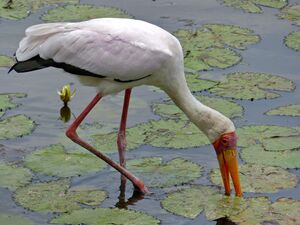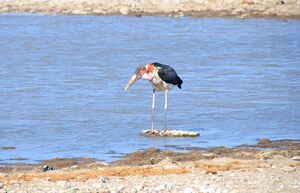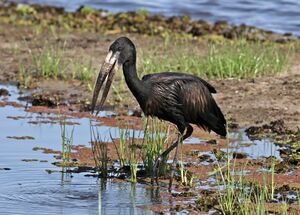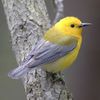لقلق
| لقلق Stork | |
|---|---|
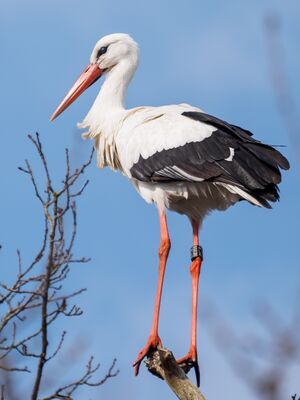
| |
| White stork (Ciconia ciconia) | |
| التصنيف العلمي | |
| مملكة: | |
| Phylum: | |
| Class: | |
| Order: | |
| Family: | لقلقية گراي، 1840
|
| الأجناس | |
اللقلق Stork طائر من الطيور المهاجرة كبيرة الحجم ذات الأرجل الطويلة ترى أعشاشه فوق المآذن وأبراج الخطوط الكهربائية و قمم أشجار العالية.
تقتات اللقالق على الحشرات والضفادع والفئران الصغيرة وأفراخ الأفاعي.
ويتابعه المتخصصين لدراسة حركة طيرانه وترحاله عن طريق مراقبته ووضع حلقات معدنية حول أسفل رجله تحوي معلومات خاصة يتبادلونها لمساعدتهم لدراسة أحواله.
يستبشر به العامة ويحافظون على أعشاشه فلا يخربونها, وقد يعاني مهندسو الصيانة عند تكليف عمالهم وفنيهم برفع أعشاشه من على الخطوط الكهربائية التي كثيرا ما تسبب دوائر قصر كهربائية خصوصا في الشتاء عندما تبتل أغصان وقش العش, فتراهم لايرفعونها بل يعيدون ترتيبها وأبعادها قليلا عن الأسلاك الكهربائية.
. . . . . . . . . . . . . . . . . . . . . . . . . . . . . . . . . . . . . . . . . . . . . . . . . . . . . . . . . . . . . . . . . . . . . . . . . . . . . . . . . . . . . . . . . . . . . . . . . . . . . . . . . . . . . . . . . . . . . . . . . . . . . . . . . . . . . . . . . . . . . . . . . . . . . . . . . . . . . . . . . . . . . . . .
غذاؤها
مع أن هذه الطيور تعتمد في غذائها على ما يوجد في البحيرات من ضفادع ورخويات وقشريات، إلا أن الطائر الذي نتكلم عنه أدهش العلماء ؛ لأنه ينطلق بسرعة نحو أي منطقة مشتعلة في المروج والغابات، وبعد مراقبة طويلة، تبين أن النيران ترغم الحشرات على الهروب السريع أو القفز في الهواء، عند ذلك ينطلق هذا الطائر؛ حتى يحصل على وجبة شهية من هذه الحشرات السهلة والذيذة، بواسطة إحساسه المدهش بوجود علاقة بين النيران والغذاء الوفير، يغنيه عن البحث الطويل في المروج أو البحيرات، عن الضفادع وغيرها من الكائنات المائية.
ورغم انتشار هذه الأنواع في معظم أنحاء العالم إلا أن هذا الطائر الجميل مهدد بالانقراض في أماكن كثيرة.
هجرة اللقلق ومميزاته
أفاد الخبير بالـس مولينا من الجمعية الإسبانية لعلوم الطيور، بأن أعداداً كبيرة من طائر اللقلق توقفت عن الهجرة وذلك بسبب ارتفاع درجة حرارة الكون. وأوضح مولينا أن طائر اللقلق الأبيض طويل الساقين والعنق والمنقار وهو من الطيور التي يعشقها الإسبان وقد بلغت أعدادها في أحدث إحصاء لها وكان ذلك العام 2004 ، 33 ألف زوج. اللقلق طائر جميل يملك عينين رائعتين تساعدانه على رؤية ممتازة أثناء الطيران، كذلك له منقار طويل ومستقبم، يستطيع أن يلتقط به الأسماك والضفادع وبعض الحشرات بسهولة, عندما يطير اللقلق يستطيع أن يميز وجهته ويمكنه بحس الاتجاه الذي زوده به الخالق -سبحانه-أن يسافر إلى المكان الذي يريد دون أن يضيع.
الفصائل
أشهر الفصائل
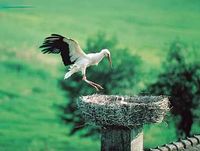
أشهر اللقالق اللقلق الأبيض. ويعيش هذا الطائر في آسيا وشمال إفريقيا وأوروبا في فصل الصيف، وفي أفريقيا، وشمالي الهند في فصل الشتاء. وهو أبيض بعلامات سوداء على جناحيه. له منقار أحمر وساقاه وقدماه بلون قرنفلي محمر. يأوي اللقلق الأبيض في كثير من الأحيان، إلى السطوح والمداخن. يعود زوج اللقلق إلى نفس العش سنة بعد أخرى. واللقلق الأبيض طائر يجد عناية وحماية في كثير من الأماكن. ومن التطير المذموم اعتقاد بعض الناس في بعض الدول أن هذا الطائر يجلب الحظ السعيد.
تشمل لقالق شرقي أوروبا الأخرى أبا سعن واللقلق الأسود، واللقلق ذا العنق الصوفي. يعيش لقلق ماگوري ولقلق جابيرو في أمريكا الوسطى وأمريكا الجنوبية. وينمو الجابيرو إلى ارتفاع 1,5 م ويزيد طول جناحه على مترين.
يعيش لقلق الغابة، وكان يسمى في السابق أبو منجل الغابة، في مستنقعات شجر السرو في فلوريدا بالولايات المتحدة، كما يعيش في المناطق الساحلية بأمريكا الوسطى والجنوبية. ويبلغ ارتفاع هذا الطائر الكبير الأبيض ما يزيد على المتر قليلاً. ويغلب اللون الأسود على جانبي جناحيه السفليين وعلى ريش الذيل.
شجرة التصنيف
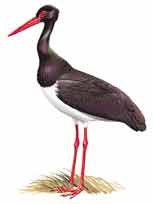
- عائلة (أي تحت رتبة) لقلقية Ciconiidae
- جنس Mycteria
- لقلق لبني Milky Stork (Mycteria cinerea)
- لقلق أصفر المنقار Yellow-billed Stork (Mycteria ibis)
- Painted Stork ( Mycteria leucocephala)
- Wood Stork (Mycteria americana)
- جنس Anastomus
- لقلق منفرج المنقار آسيوي Asian Openbill Stork, Anastomus oscitans
- لقلق منفرج المنقار أفريقي African Openbill Stork, Anastomus lamelligerus
- جنس Ciconia
- لقلق أبديم Abdim's Stork, Ciconia abdimii
- لقلق صوفي العنق, Ciconia episcopus
- Storm's Stork, Ciconia stormi
- Maguari Stork, Ciconia maguari
- لقلق أبيض شرقي Oriental White Stork, Ciconia boyciana
- لقلق أبيض White Stork Ciconia ciconia
- لقلق أسود Black Stork Ciconia nigra
- جنس Ephippiorhynchus
- Black-necked Stork, Ephippiorhynchus asiaticus
- لقلق أبو سرج Saddle-billed Stork, Ephippiorhynchus senegalensis
- جنس جابيرو Jabiru
- جابيرو Jabiru mycteria
- جنس Leptoptilos
- أبو سعن صغير Lesser Adjutant, Leptoptilos javanicus
- أبو سعن كبير Greater Adjutant, Leptoptilos dubius
- أبو سعن أفريقي Marabou Stork, Leptoptilos crumeniferus
- جنس Mycteria
لقالق متحجرة
- Genus Palaeoephippiorhynchus (fossil: Early Oligocene of Fayyum, Egypt)
- Genus Grallavis (fossil: Early Miocene of Saint-Gérand-le-Puy, France, and Djebel Zelten, Libya) – may be same as Prociconia
- Ciconiidae gen. et sp. indet. (Ituzaingó Late Miocene of Paraná, Argentina)[note 1][1][2]
- Ciconiidae gen. et sp. indet. (Puerto Madryn Late Miocene of Punta Buenos Aires, Argentina)[note 2][2]
- Genus Prociconia (fossil: Late Pleistocene of Brazil) – may belong to modern genus Jabiru or Ciconia
- Genus Pelargosteon (fossil: Early Pleistocene of Romania)
- Ciconiidae gen. et sp. indet. – formerly Aquilavus/Cygnus bilinicus (fossil: Early Miocene of Břešťany, Czech Republic)
- cf. Leptoptilos gen. et sp. indet. – formerly L. siwalicensis (fossil: Late Miocene? – Late Pliocene of Siwalik, India)[3]
- Ciconiidae gen. et sp. indet. (fossil: Late Pleistocene of San Josecito Cavern, Mexico)[4]
- Ciconia nana (fossil: Pleistocene of Darling Downs, Queensland, Australia, and Ciconia louisebolesae fossil: Olig-Miocene of Riversleigh WHA, Queensland, Australia[5]
The fossil genera Eociconia (Middle Eocene of China) and Ciconiopsis (Deseado Early Oligocene of Patagonia, Argentina) are often tentatively placed with this family. A "ciconiiform" fossil fragment from the Touro Passo Formation found at Arroio Touro Passo (Rio Grande do Sul, Brazil) might be of the living wood stork M. americana; it is at most of Late Pleistocene age, a few 10,000s of years.[6]
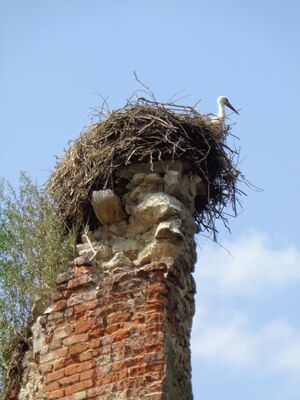
الشكل
Storks range in size from the marabou, which stands 152 cm (60 in) tall and can weigh 8.9 kg (19+1⁄2 lb), to the Abdim's stork, which is only 75 cm (30 in) high and weighs only 1.3 kg (2+3⁄4 lb). Their shape is superficially similar to the herons, with long legs and necks, but they are more heavy-set. There is some sexual dimorphism (differences between males and females) in size, with males being up to 15% bigger than females in some species (for example the saddle-billed stork), but almost no difference in appearance. The only difference is in the colour of the iris of the two species in the genus Ephippiorhynchus.[7]
The bills of storks are large to very large, and vary considerably between the genera. The shape of the bills is linked to the diet of the different species. The large bills of the Ciconia storks are the least specialized. Larger are the massive and slightly upturned bills of the Ephippiorhynchus and the jabiru. These have evolved to hunt for fish in shallow water. Larger still are the massive daggers of the two adjutants and marabou (Leptoptilos), which are used to feed on carrion and in defense against other scavengers, as well as for taking other prey.[7] The long, ibis-like downcurved bills of the Mycteria storks have sensitive tips that allow them to detect prey by touch (tactilocation) where cloudy conditions would not allow them to see it.[8] The most specialised bills of any storks are those of the two openbills (Anastomus), which as their name suggests, is open in the middle when their bill is closed. These bills have evolved to help openbills feed on their primary prey item, aquatic snails.[9]
Although it is sometimes reported that storks lack syrinxes and are mute,[10] they do have syrinxes,[11] and are capable of making some sounds, although they do not do so often.[7][12] The syrinxes of storks are "variably degenerate" however,[11] and the syringeal membranes of some species are found between tracheal rings or cartilage, an unusual arrangement shared with the ovenbirds.[13]
التوزع والموئل
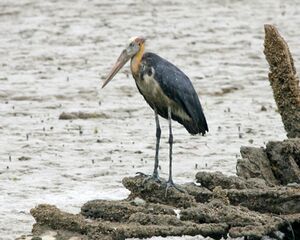
Storks have a nearly cosmopolitan distribution, being absent from the poles, most of North America and large parts of Australia. The centres of stork diversity are in tropical Asia and sub-Saharan Africa, with eight and six breeding species respectively. Just three species are present in the New World: wood stork, maguari stork and jabiru, which is the tallest flying bird of the Americas. Two species, white and black stork, reach Europe and western temperate Asia, while one species, Oriental stork, reaches temperate areas of eastern Asia, and one species, black-necked stork, is found in Australasia.[7]
Storks are more diverse and common in the tropics, and the species that live in temperate climates for the most part migrate to avoid the worst of winter. They are fairly diverse in their habitat requirements. Some species, particularly the Mycteria "wood storks" and Anastomus openbills, are highly dependent on water and aquatic prey, but many other species are far less dependent on this habitat type, although they will frequently make use of it. Species like the marabou and Abdim's stork will frequently be found foraging in open grasslands of savannah. Preferred habitats include flooded grasslands, light woodland, marshes and paddyfields, wet meadows, river backwaters and ponds. Many species will select shallow pools, particularly when lakes or rivers are drying out, as they concentrate prey and make it harder for prey to escape, or when monsoonal rainfall increases water depth of larger waterbodies.[7][14] Some species like the woolly-necked storks and lesser adjutant storks have adapted to changing crops of tropical agricultural landscapes that enables them to remain resident despite the transformations brought about by seasonal crops.[15][16][17][18] In South Africa, the woolly-necked storks have adapted to artificial feeding and now largely nest on trees in gardens with swimming pools.[19]
Less typical habitats include the dense temperate forests used by European black storks, or the rainforest habitat sought by Storm's stork in South East Asia. They generally avoid marine habitats, with the exception of the lesser adjutant, milky stork and wood stork, all of which forage in mangroves, lagoons and estuarine mudflats. A number of species, especially woolly-necked storks, black-necked storks, Asian openbills and lesser adjutant Storks in south Asia, have adapted to highly modified human habitats, for foraging and breeding.[14][20][21][22] In the absence of persecution several stork species breed close to people, and species such as the marabou, greater adjutant, and white stork feed at landfill sites.[7][23]
. . . . . . . . . . . . . . . . . . . . . . . . . . . . . . . . . . . . . . . . . . . . . . . . . . . . . . . . . . . . . . . . . . . . . . . . . . . . . . . . . . . . . . . . . . . . . . . . . . . . . . . . . . . . . . . . . . . . . . . . . . . . . . . . . . . . . . . . . . . . . . . . . . . . . . . . . . . . . . . . . . . . . . . .
الهجرة والحركات
Storks vary in their tendency towards migration. Temperate species like the white stork, black stork and Oriental stork undertake long annual migrations in the winter. The routes taken by these species have developed to avoid long distance travel across water, and from Europe this usually means flying across the Straits of Gibraltar or east across the Bosphorus and through Israel and the Sinai.[7] Studies of young birds denied the chance to travel with others of their species have shown that these routes are at least partially learnt, rather than being innate as they are in passerine migrants.[24] Migrating black storks are split between those that make stopovers on the migration between Europe and their wintering grounds in Africa, and those that do not.[25]
The Abdim's stork is another migrant, albeit one that migrates within the tropics. It breeds in northern Africa, from Senegal to the Red Sea, during the wet season, and then migrates to Southern Africa.[26] Many species that are not regular migrants will still make smaller movements if circumstances require it; others may migrate over part of their range. This can also include regular commutes from nesting sites to feeding areas. Wood storks have been observed feeding 130 km (80 mi) from their breeding colony.[7]
السلوك
الإطعام والمأكل
Storks are carnivorous predators, taking a range of reptiles, small mammals, insects, fish, amphibians and other small invertebrates. Storks usually hunt for animals in shallow water. Any plant material consumed is usually by accident. Mycteria storks are specialists in feeding on aquatic vertebrates, particularly when prey is concentrated by lowering water levels or flooding into shallows. On marine mudflats and mangrove swamps in Sumatra, milky storks feed on mudskippers, probing the burrow with the bill and even the whole head into the mud.[بحاجة لمصدر] The characteristic feeding method involves standing or walking in shallow water and holding the bill submerged in the water. When contact is made with prey the bill reflexively snaps shut in 25 milliseconds, one of the fastest reactions known in any vertebrate. The reaction is able to distinguish between prey items and inanimate objects like branches, although the exact mechanism is unknown.[27][7]
Openbills are specialists in freshwater molluscs, particularly apple snails. They feed in small groups,[14] and sometimes African openbills ride on the backs of hippos while foraging. Having caught a snail it will return to land or at least to the shallows to eat it. The fine tip of the bill of the openbills is used to open the snail, and the saliva has a narcotic effect, which causes the snail to relax and simplifies the process of extraction.[7]
The other genera of storks are more generalised. Ciconia storks are very generalised in their diets, and some species including Abdim's stork and marabous will feed in large flocks on swarms of locusts and at wildfires.[7][28] This is why white storks and Abdim's storks are known as "grasshopper birds". Ephippiorhynchus are carnivorous though have a very diverse diet when living on human modified habitats such as agricultural landscapes.[29] The foraging method used by the generalists is to stalk or walk across grassland or shallow water, watching for prey.[7]
التزاوج
Storks range from being solitary breeders through loose breeding associations to fully colonial. The jabiru, Ephippiorhynchus storks and several species of Ciconia are entirely solitary when breeding.[22][30][31] In contrast the Mycteria storks, Abdim's stork, openbills and Leptoptilos storks breed in colonies which can range from a couple of pairs to thousands.[15][20][21] Many of these species breed in colonies with other waterbirds, which can include other species of storks, herons and egrets, pelicans, cormorants and ibises. White storks, Oriental storks and Maguari storks are all loosely colonial, and may breed in nests that are within visual range of others of the same species, but have little to do with one another. They also may nest solitarily, and the reasons why they choose to nest together or apart are not understood.[7] Storks use trees in a variety of habitats to breed including forests, cities, farmlands, and large wetlands.[16][19][20][32]
في الثقافة
Many ancient mythologies feature stories and legends involving storks. In Ancient Egypt, saddle-billed storks were seen as being amongst the most powerful animals and were used to represent the ba, the Ancient Egyptian conception of the soul, during the Old Kingdom.[33] Bennu, an Egyptian deity that was later the inspiration for the phoenix, may also have been inspired by a stork, although it was more likely an ibis or heron.[34][35]
Greek and Roman mythology portrays storks as models of parental devotion. The 3rd century Roman writer Aelian, citing the authority of Alexander of Myndus, noted in his De natura animalium (book 3, chapter 23) that aged storks flew away to oceanic islands where they were transformed into humans as a reward for their piety towards their parents.[36] Storks were also thought to care for their aged parents, feeding them and even transporting them, and children's books depicted them as a model of filial values. A Greek law called Pelargonia, from the Ancient Greek word pelargos for stork, required citizens to take care of their aged parents.[بحاجة لمصدر] The Greeks also held that killing a stork could be punished with death.[37]
Storks feature in several of Aesop's Fables, most notably in The Farmer and the Stork, The Fox and the Stork, and The Frogs Who Desired a King. The first fable involves a stork who is caught with a group of cranes who are eating grain in a farmer's field, with the moral that those who associate with wicked people can be held accountable for their crimes.[38] The Fox and the Stork involves a fox who invites a stork for dinner and provides soup in a dish that the stork cannot drink from, and is in turn invited for dinner by the stork and given food in a narrow jug which he cannot access. It cautions readers to follow the principle of do no harm.[39] The third fable involves a group of frogs that are dissatisfied with the king that Zeus has given them, an inanimate log, and who are then punished with a new King Stork (a water-snake in some versions) who eats the frogs.[40][41] King Stork has subsequently entered the English language as a term for a particularly tyrannical ruler.[42]
الاقتران بالخصوبة
According to European folklore, the white stork is responsible for bringing babies to new parents. The legend is very ancient, but was popularised by a 19th-century Hans Christian Andersen story called "The Storks".[43] German folklore held that storks found babies in caves or marshes and brought them to households in a basket on their backs or held in their beaks. These caves contained adebarsteine or "stork stones". The babies would then be given to the mother or dropped down the chimney. Households would notify when they wanted children by placing sweets for the stork on the window sill.[44] Subsequently, the folklore has spread around the world to the Philippines and countries in South America.[44] Birthmarks on the back of the head of newborn babies, nevus flammeus nuchae, are sometimes referred to as stork-bite.[45] In Slavic mythology and pagan religion, storks were thought to carry unborn souls from Vyraj to Earth in spring and summer.[46] This belief still persists in the modern folk culture of many Slavic countries, in the simplified child story that "storks bring children into the world".[47][48]
Psychoanalyst Marvin Margolis suggests the enduring nature of the stork fable of the newborn is linked to its addressing a psychological need, in that it allays the discomfort of discussing sex and procreation with children. Birds have long been associated with the maternal symbols from pagan goddesses such as Juno to the Holy Ghost, and the stork may have been chosen for its white plumage (depicting purity), size, and flight at high altitude (likened to flying between Earth and Heaven).[44]
There were negative aspects to stork folklore as well; a Polish folk tale relates how God made the stork's plumage white, while the Devil gave it black wings, imbuing it with both good and evil impulses. They were also associated with handicapped or stillborn babies in Germany, explained as the stork having dropped the baby en route to the household, or as revenge or punishment for past wrongdoing. A mother who was confined to bed around the time of childbirth was said to have been "bitten" by the stork. In Denmark, storks were said to toss a nestling off the nest and then an egg in successive years.[44] In medieval England, storks were also associated with adultery, possibly inspired by their courtship rituals. Their preening and posture saw them linked with the attribute of self-conceit.[49] Children of African American slaves were sometimes told that white babies were brought by storks, while black babies were born from buzzard eggs.[50]
. . . . . . . . . . . . . . . . . . . . . . . . . . . . . . . . . . . . . . . . . . . . . . . . . . . . . . . . . . . . . . . . . . . . . . . . . . . . . . . . . . . . . . . . . . . . . . . . . . . . . . . . . . . . . . . . . . . . . . . . . . . . . . . . . . . . . . . . . . . . . . . . . . . . . . . . . . . . . . . . . . . . . . . .
As food
Storks have never been a particularly common food, but occasionally featured in medieval banquets.[51] They may also have been eaten in Ancient Egypt.[52]
انظر أيضاً
ملاحظات
- ^ Tarsometatarsus fragments somewhat similar to Mycteria
- ^ Specimen MEF 1363: Incomplete skeleton of a large stork somewhat similar to Jabiru but apparently more plesiomorphic
الهامش
- ^ Cione, Alberto Luis; de las Mercedes Azpelicueta, María; Bond, Mariano; Carlini, Alfredo A.; Casciotta, Jorge R.; Cozzuol, Mario Alberto; de la Fuente, Marcelo; Gasparini, Zulma; Goin, Francisco J.; Noriega, Jorge; Scillatoyané, Gustavo J.; Soibelzon, Leopoldo; Tonni, Eduardo Pedro; Verzi, Diego; Guiomar Vucetich, María (2000). "Miocene vertebrates from Entre Ríos province, eastern Argentina" (PDF). In Aceñolaza, F.G.; Herbst, R. (eds.). El Neógeno de Argentina. Serie Correlación Geológica (in الإنجليزية and الإسبانية). Vol. 14. INSUGEO. pp. 191–237. Archived from the original (PDF) on 2008-02-28.
- ^ أ ب Noriega, Jorge Ignacio & Cladera, Gerardo (2005). First Record of Leptoptilini (Ciconiiformes: Ciconiidae) in the Neogene of South America. Abstracts of Sixth International Meeting of the Society of Avian Paleontology and Evolution: 47. PDF fulltext Archived 2008-02-28 at the Wayback Machine
- ^ Specimens BMNH 39741 (holotype, left proximal tarsometatarsus) and BMNH 39734 (right distal tibiotarsus). Similar to Ephippiorhynchus and Leptotilos, may be from a small female of Leptotilos falconeri, from L. dubius, or from another species: Louchart, Antoine; Vignaud, Patrick; Likius, Andossa; Brunet, Michel & White, Tim D. (2005). "A large extinct marabou stork in African Pliocene hominid sites, and a review of the fossil species of Leptoptilos" (PDF). Acta Palaeontologica Polonica. 50 (3): 549–563. Archived from the original (PDF) on 2008-02-28. Retrieved 2008-01-15.
- ^ Distal radius of a mid-sized Ciconia or smallish Mycteria: Steadman, David W.; Arroyo-Cabrales, Joaquin; Johnson, Eileen & Guzman, A. Fabiola (1994). "New Information on the Late Pleistocene Birds from San Josecito Cave, Nuevo León, Mexico" (PDF). Condor. 96 (3): 577–589. doi:10.2307/1369460. JSTOR 1369460.
- ^ Boles. A review of the Australian fossil storks of the genus ''Ciconia'' (Aves:Ciconiidae), with a description of a new species|journal=Records of the Australian Museum (2005) Vol=57, pages= 165–178
- ^ Schmaltz Hsou, Annie (2007). O estado atual do registro fóssil de répteis e aves no Pleistoceno do Estado do Rio Grande do Sul, Brasil ["The current state of the fossil record of Pleistocene reptiles and birds of Rio Grande do Sul"]. Talk held on 2007-JUN-20 at Quaternário do RS: integrando conhecimento, Canoas, Rio Grande do Sul, Brazil. PDF abstract Archived 2017-07-08 at the Wayback Machine
- ^ أ ب ت ث ج ح خ د ذ ر ز س ش del Hoyo, J. Elliott, A. & Sargatal, J. (1992). Handbook of the Birds of the World. Volume 1: Ostrich to Ducks. Lynx Edicions. ISBN 84-87334-10-5.
- ^ Coulter, Malcolm C.; Bryan, A. Lawrence (1 January 1993). "Foraging Ecology of Wood Storks (Mycteria americana) in East-Central Georgia I. Characteristics of Foraging Sites". Colonial Waterbirds. 16 (1): 59–70. doi:10.2307/1521557. JSTOR 1521557.
- ^ Kahl, M. P. (January 1971). "Food and feeding behavior of Openbill Storks". Journal of Ornithology. 112 (1): 21–35. Bibcode:1971JOrni.112...21K. doi:10.1007/BF01644077. S2CID 1484358.
- ^ Spring Alive. "A bird without voice". Retrieved 7 March 2017.
- ^ أ ب Griffiths, Carole S. (October 1994). "Monophyly of the Falconiformes Based on Syringeal Morphology". The Auk. 111 (4): 787–805. doi:10.2307/4088811. JSTOR 4088811. S2CID 53388019.
- ^ Sundar, K.S. Gopi (2005). "An instance of mortality and notes on behaviour of black-necked storks Ephippiorhynchus asiaticus". Journal of the Bombay Natural History Society. 102 (1): 99–102.
- ^ Casey, Richard M.; Gaunt, Abbot S. (September 1985). "Theoretical models of the avian syrinx". Journal of Theoretical Biology. 116 (1): 45–64. Bibcode:1985JThBi.116...45C. doi:10.1016/S0022-5193(85)80130-2.
- ^ أ ب ت Sundar, K.S. Gopi (2006). "Flock Size, Density and Habitat Selection of Four Large Waterbirds Species in an Agricultural Landscape in Uttar Pradesh, India: Implications for Management". Waterbirds. 29 (3): 365–374. doi:10.1675/1524-4695(2006)29[365:FSDAHS]2.0.CO;2. S2CID 198154724.
- ^ أ ب Katuwal, Hem B.; Sundar, K. S. Gopi; Zhang, M; Rimal, B; Baral, H. S.; Sharma, H. P.; Ghimire, P; Hughes, A. C.; Quan, R.-C. (2022). "Factors affecting the breeding ecology of the globally threatened Lesser Adjutant (Leptoptilos javanicus) in agricultural landscapes of Nepal". Avian Conservation and Ecology. 17 (2): 15. doi:10.5751/ACE-02235-170215. S2CID 251862746.
- ^ أ ب Kittur, Swati; Sundar, K. S. Gopi (2021). "Of irrigation canals and multifunctional agroforestry: Traditional agriculture facilitates Woolly-necked Stork breeding in a north Indian agricultural landscape". Global Ecology and Conservation. 30 (October 2021): e01793. doi:10.1016/j.gecco.2021.e01793. S2CID 239153561.
- ^ Ghimire, P; Pandey, N; Timilsina, Y. P.; Bist, B. S.; Sundar, K. S. Gopi (2021). "Woolly-Necked Stork (Ciconia episcopus) activity budget in lowland Nepal's farmlands: the influence of wetlands, seasonal crops, and human proximity". Waterbirds. 44 (4): 415–424. doi:10.1675/063.044.0403. S2CID 251161403.
- ^ Sundar, K. S. Gopi; Maharjan, B; Koju, Roshila; Kittur, Swati; Gosai, Kamal R. (2016). "Factors affecting provisioning times of two stork species in lowland Nepal". Waterbirds. 39 (4): 365–374. doi:10.1675/063.039.0406. S2CID 90680383.
- ^ أ ب Thabethe, V; McPherson, S; Downs, C. T. (2021). "Diet of nestling African woolly-necked storks in suburban areas of KwaZulu-Natal, South Africa". African Journal of Ecology. 59 (3): 769–772. doi:10.1111/aje.12859. S2CID 233950996.
- ^ أ ب ت Koju, Roshila; Maharjan, Bijay; Gosai, Kamal Raj; Kittur, Swati; Sundar, K.S. Gopi (2019). "Ciconiiformes nesting on trees in cereal-dominated farmlands: importance of scattered trees for heronries in lowland Nepal". Waterbirds. 42 (4): 355–365. doi:10.1675/063.042.0401. S2CID 210861485.
- ^ أ ب Sundar, K.S. Gopi; Maharjan, Bijay; Koju, Roshila; Kittur, Swati; Gosai, Kamal Raj (2016). "Factors affecting provisioning times of two stork species in lowland Nepal". Waterbirds. 39 (4): 365–374. doi:10.1675/063.039.0406. S2CID 90680383.
- ^ أ ب Kittur, Swati; Sundar, K. S. Gopi (2021). "Of irrigation canals and multifunctional agroforestry: Traditional agriculture facilitates Woolly-necked Stork breeding in a north Indian agricultural landscape". Global Ecology and Conservation. 30: e01793. doi:10.1016/j.gecco.2021.e01793. ISSN 2351-9894. S2CID 239153561.
- ^ Tortosa, F. S.; Caballero, J. M.; Reyes-López, J. (March 2002). "Effect of Rubbish Dumps on Breeding Success in the White Stork in Southern Spain". Waterbirds. 25 (1): 39–43. doi:10.1675/1524-4695(2002)025[0039:EORDOB]2.0.CO;2. S2CID 85703087.
- ^ Chernetsov, N.; Berthold, P.; Querner, U. (22 February 2004). "Migratory orientation of first-year white storks (Ciconia ciconia): inherited information and social interactions". Journal of Experimental Biology. 207 (6): 937–943. doi:10.1242/jeb.00853. PMID 14766952.
- ^ Chevallier, D.; Le Maho, Y.; Brossault, P.; Baillon, F.; Massemin, S. (5 June 2010). "The use of stopover sites by Black Storks (Ciconia nigra) migrating between West Europe and West Africa as revealed by satellite telemetry". Journal of Ornithology. 152 (1): 1–13. doi:10.1007/s10336-010-0536-6. S2CID 21513063.
- ^ Adjakpa, Jacques Boco (January 2000). "The breeding biology of Abdim's Stork in the far north of Benin". Ostrich. 71 (1–2): 61–63. doi:10.1080/00306525.2000.9639869. S2CID 84995962.
- ^ Kahl, M. P.; Peacock, L. J. (3 August 1963). "The Bill-snap Reflex : a Feeding Mechanism in the American Wood Stork". Nature. 199 (4892): 505–506. Bibcode:1963Natur.199..505K. doi:10.1038/199505a0. PMID 14058622. S2CID 332546.
- ^ Dean, G. J. W. (June 1964). "Stork and egret as predators of the red locust in the Rukwa Valley outbreak area". Ostrich. 35 (2): 95–100. Bibcode:1964Ostri..35...95D. doi:10.1080/00306525.1964.9633490.
- ^ Sundar, K.S. Gopi (2011). "Farmland foods: Black-necked Stork Ephippiorhynchus asiaticus prey items in an agricultural landscape" (PDF). Forktail. 27: 98–99.
- ^ Sundar, K.S. Gopi (2003). "Notes on the breeding biology of the Black-necked Stork Ephippiorhynchus asiaticus in Etawah and Mainpuri districts, Uttar Pradesh, India". Forktail. 19: 15–20.
- ^ Sundar, K.S. Gopi (2011). "Agricultural intensification, rainfall patterns, and large waterbird breeding success in the extensively cultivated landscape of Uttar Pradesh, India". Biological Conservation. 144 (12): 3055–3063. Bibcode:2011BCons.144.3055G. doi:10.1016/j.biocon.2011.09.012.
- ^ Urfi, Abdul J. (2010). s13280-010-0018-3 "Using heronry birds to monitor urbanization impacts: a case study of Painted Stork Mycteria leucocephala nesting in the Delhi Zoo, India". Ambio. 39: 190–193.
{{cite journal}}: Check|url=value (help) - ^ Janák, Jiří (2014). "Saddle-billed Stork (ba-bird)" (PDF). In Wendrich, Willeke (ed.). UCLA Encyclopedia of Egyptology (in الإنجليزية). Los Angeles. pp. 1–2, 4.
{{cite book}}: CS1 maint: location missing publisher (link) - ^ Buckland, A. W. (1875). "Mythological Birds Ethnologically Considered" (PDF). The Journal of the Anthropological Institute of Great Britain and Ireland. 4: 283. doi:10.2307/2841232. JSTOR 2841232.
- ^ Chadd, Rachel Warren; Taylor, Marianne (2016). Birds: myth, lore & legend. London New York, NY: Bloomsbury Natural History. p. 19. ISBN 978-1-4729-2288-5.
- ^ Schofield, A.F., ed. (1958). Aelian on the characteristics of animals. Volume I. Books I-V. Harvard University Press. p. 185.
- ^ Dolata, Pawel T. (2006). "The White Stork Ciconia ciconia Protection in Poland by Fradition, Customs, Law, and Active Efforts". In Tryjanowski, Piotr; Sparks, Tim H.; Jerzak, L. (eds.). The White Stork in Poland: Studies in Biology, Ecology and Conservation. Poznań, Poland: Bogucki Wydawnictwo Naukowe. ISBN 978-83-60247-35-8.
- ^ "THE STORK AND THE CRANES". mythfolklore.net. Retrieved 2023-07-30.
- ^ "THE FOX AND THE STORK". mythfolklore.net. Retrieved 2023-07-30.
- ^ "JUPITER AND THE FROGS". mythfolklore.net. Retrieved 2023-07-30.
- ^ Brewer, Ebenezer Cobham (2012). Dent, Susie (ed.). Brewer's Dictionary of Phrase & Fable (in الإنجليزية) (19 ed.). London: Chambers Harrap. p. 482. ISBN 978-0-550-10245-4.
- ^ "King Log". Oxford English Dictionary (Online ed.). Oxford University Press. doi:10.1093/OED/4893537697. Retrieved 2023-07-30. قالب:OEDsub
- ^ Sax, Boria (2001). The Mythical Zoo. Oxford, UK: ABC-CLIO. pp. 153–154. ISBN 978-1-57607-612-5.
- ^ أ ب ت ث Margolis, Marvin; Parker, Philip (1972). "The stork fable−some psychodynamic considerations". Journal of the American Psychoanalytic Association. 20 (3): 494–511. doi:10.1177/000306517202000304. PMID 4116100. S2CID 45301787.
- ^ Jacobs, Alvin H.; Walton, Robert G. (1976). "The incidence of birthmarks in the neonate". Pediatrics. 58 (2): 218–22. doi:10.1542/peds.58.2.218. PMID 951136. S2CID 245028603.
- ^ Gieysztor, Aleksander (1982). Mitologia Słowian (in البولندية). Warsaw: Wydawnictwa Artystyczne i Filmowe. ISBN 978-83-221-0152-0.
- ^ Jakubiec, Z. (2009). "Dlaczego bocian przynosił dzieci?". Bocianopedia (in البولندية). Retrieved 10 March 2011.
- ^ Szczepanowicz, Barbara (2005). "Ptaki Ziemi Świętej: Bocian, czapla, ibis" [Birds in the Holy Land: Stork, heron, ibis]. Ziemia Święta (in البولندية) (rok XI 1(41)). Retrieved 8 February 2011.
- ^ de Vries, Ad (1976). Dictionary of Symbols and Imagery. Amsterdam: North-Holland Publishing Company. p. 445. ISBN 978-0-7204-8021-4.
- ^ Bay, Mia (2000). The White Image in the Black Mind: African-American Ideas about White People, 1830–1925. New York: Oxford University Press. p. 120. ISBN 978-0-19-513279-3.
- ^ Davidson, Alan (2013). Jaine, Tom (ed.). The Oxford companion to food (2 ed.). Oxford: Oxford University Press. p. 780. ISBN 978-0-19-280681-9.
- ^ Ikram, Salima (1995). Choice cuts: meat production in ancient Egypt. Orientalia Lovaniensia analecta. Leuven: Peeters. pp. 25–26. ISBN 978-90-6831-745-9.
وصلات خارجية
 Chisholm, Hugh, ed. (1911). . دائرة المعارف البريطانية (eleventh ed.). Cambridge University Press.
Chisholm, Hugh, ed. (1911). . دائرة المعارف البريطانية (eleventh ed.). Cambridge University Press. {{cite encyclopedia}}: Cite has empty unknown parameter:|coauthors=(help) "[[s:Collier's New Encyclopedia (1921)/{{{1}}}|{{{1}}}]]". Collier's New Encyclopedia. 1921.
"[[s:Collier's New Encyclopedia (1921)/{{{1}}}|{{{1}}}]]". Collier's New Encyclopedia. 1921.- Scott MacDonald, "The Stork" emblematic uses
- Storks Image documentation
- Stork videos on the Internet Bird Collection
- Whitestork Photos Image documentation
- Storks vocalizing
خطأ لوا في وحدة:Authority_control على السطر 278: attempt to call field '_showMessage' (a nil value).
- CS1 الإسبانية-language sources (es)
- CS1 errors: URL
- CS1 maint: location missing publisher
- CS1 البولندية-language sources (pl)
- Short description is different from Wikidata
- Articles with hatnote templates targeting a nonexistent page
- Articles with unsourced statements from April 2021
- مقالات ذات عبارات بحاجة لمصادر
- مقالات المعرفة المحتوية على معلومات من دائرة المعارف البريطانية طبعة 1911
- لقلقيات
- طيور خواضة
- Storks
- Extant Rupelian first appearances
- Taxa named by John Edward Gray
